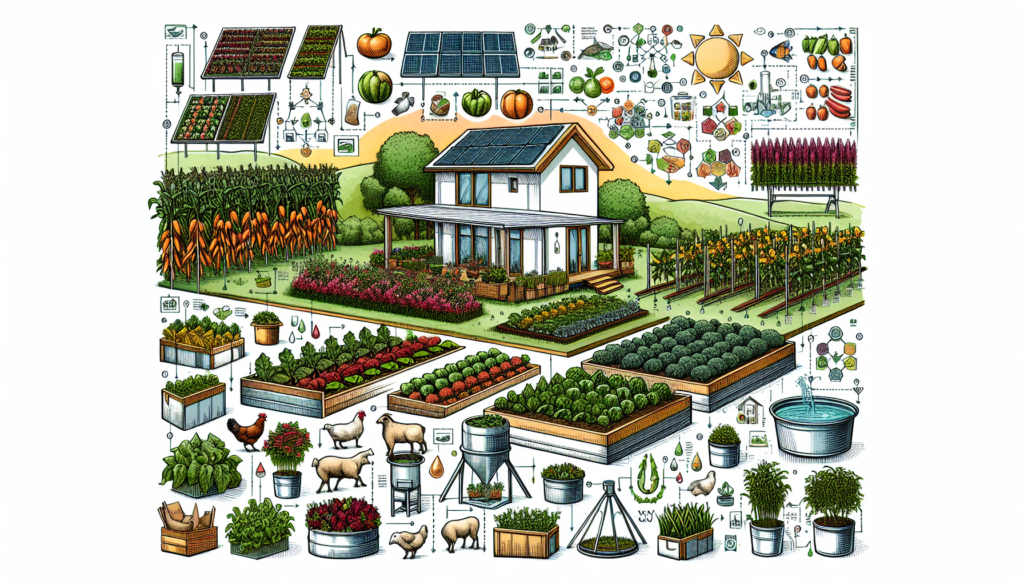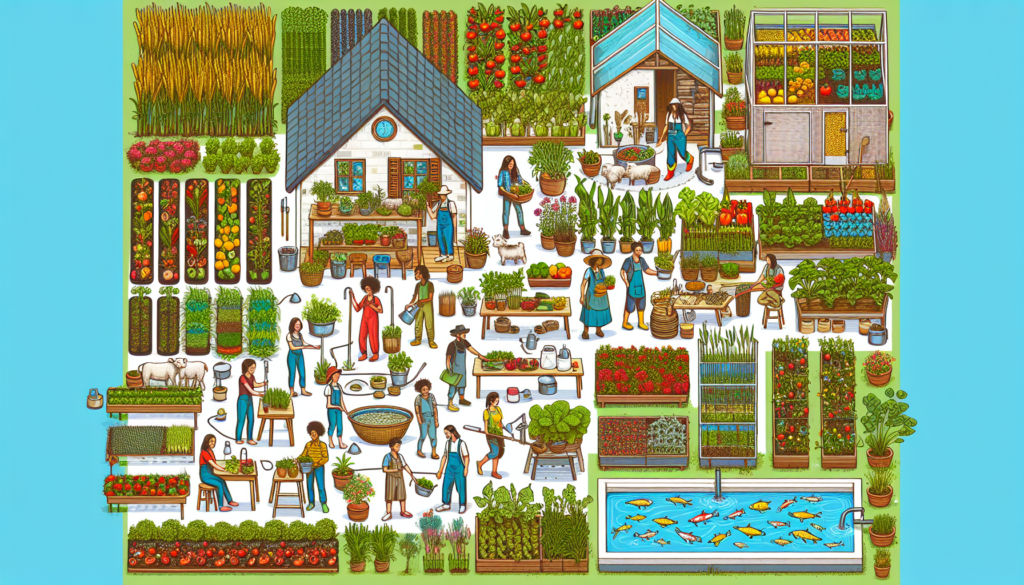Are you looking to establish a home-based food supply network? Look no further! In this article, we will provide you with valuable insights and tips on how to create a thriving food supply network right from the comfort of your own home. From optimizing your articles with proper SEO techniques to enhancing user-friendliness through the inclusion of bullet points, specification tables, and comparison tables, we have got you covered. So, let’s dive in and explore the wonderful world of home-based food supply networks!

Finding Local Food Sources
Researching Local Farms and Farmers Markets
When it comes to finding local food sources, one of the first steps is to research local farms and farmers markets in your area. Take the time to learn about the different farms and what they offer. Look for farms that prioritize sustainable and organic practices, as this can ensure that you are getting high-quality, nutritious food. Farmers markets are also a great place to find a wide variety of locally grown produce, meats, and other food products.
Joining Community Supported Agriculture (CSA) groups
Another great way to access local food is by joining Community Supported Agriculture (CSA) groups. These groups allow you to purchase a share of a farm’s produce for a season or year. By joining a CSA, you not only support local farmers but also receive a regular supply of fresh, seasonal produce. Some CSAs also offer additional products such as eggs, meat, or dairy.
Connecting with Local Food Producers and Suppliers
To expand your local food sources, it’s important to connect with local food producers and suppliers. This can include reaching out to local food cooperatives, artisanal food producers, or specialty food shops. These connections can help you access a wider range of locally sourced ingredients and products. Building relationships with these producers and suppliers can also lead to valuable knowledge and networking opportunities within the local food community.
Building Relationships
Networking in the Local Food Community
To truly establish a home-based food supply network, it’s essential to network within the local food community. Attend local food-related events, such as farmers markets, food festivals, or workshops. These events provide opportunities to meet like-minded individuals, connect with local farmers and producers, and learn more about sustainable food practices. Building relationships within the community can lead to valuable connections, collaborations, and even potential partnerships.
Attending Food-related Events and Workshops
In addition to networking events, attending food-related events and workshops can provide valuable knowledge and skills. Look for workshops or classes that focus on topics such as urban gardening, food preservation, or sustainable farming techniques. These events can provide practical information and guidance on establishing and maintaining your home-based food supply network. They also offer opportunities to connect with experts and other individuals who share your passion for local, sustainable food.
Joining Online Groups and Forums
In today’s digital age, online platforms offer another way to build relationships within the local food community. Joining online groups or forums dedicated to sustainable food practices can connect you with individuals who share your interests and goals. These groups provide a space to ask questions, seek advice, and share experiences. Online communities also often share valuable resources, such as recommended farms or suppliers, upcoming events, or tips for successful home gardening or farming.
Setting Up a Home Garden or Farm
Assessing Available Space and Resources
Before setting up a home garden or farm, assess the available space and resources you have. Consider factors such as sunlight exposure, soil quality, and available water sources. Based on these considerations, determine the suitable size and type of garden or farm you can establish. If you have limited space, container gardening or vertical gardening techniques can be utilized. If you have more land available, you might consider establishing raised beds or even a small-scale livestock farm.
Choosing Suitable Crops or Livestock
Once you have assessed your available space, choose suitable crops or livestock to cultivate. Consider climate, soil conditions, and plant or animal preferences. Opt for locally adapted varieties that have a higher chance of success in your specific environment. If you’re new to gardening or farming, start with easy-to-grow crops or low-maintenance livestock breeds. Consider factors such as crop rotation, companion planting, or rotational grazing to maximize yield and reduce pest or disease pressure.
Learning About Sustainable Farming Practices
To ensure a sustainable home-based food supply network, it’s crucial to learn about sustainable farming practices. This includes organic gardening methods, such as using natural fertilizers and pest control methods, as well as water conservation techniques. Consider implementing practices such as composting, which turns organic waste into valuable soil amendments, or utilizing cover crops to improve soil health and prevent erosion. Learn about integrated pest management strategies to minimize the use of chemical pesticides and promote natural pest control.
Planning and Implementing the Design
After assessing available space, choosing suitable crops or livestock, and learning about sustainable farming practices, it’s time to plan and implement the design of your home garden or farm. Create a detailed layout that takes into account the specific needs of each crop or livestock. Consider factors such as spacing, irrigation systems, and fencing. Implement the design gradually, starting with a manageable area and expanding as you gain experience and confidence. Regularly assess and adjust the design as necessary to optimize efficiency, productivity, and sustainability.
Creating a Food Preservation Plan
Learning Different Food Preservation Techniques
Once you have established a home-based food supply network, it’s important to have a food preservation plan in place to maximize the use of your harvest and minimize food waste. Learn different food preservation techniques such as canning, freezing, dehydrating, and fermenting. Each technique has its advantages and limitations, so familiarize yourself with the specific requirements and processes for each method. Experiment with different recipes and preservation methods to find the ones that work best for you and your family’s preferences.
Investing in necessary equipment and supplies
To effectively preserve your homegrown produce or locally sourced food, invest in the necessary equipment and supplies. This may include canning jars, a pressure canner, a dehydrator, freezer bags or containers, and fermentation crocks. Research the best brands or models suitable for your specific needs and budget. Having the right tools and equipment will make the food preservation process more efficient and ensure the quality and longevity of your preserved food.
Establishing a Schedule and Tracking System
To stay organized and prevent food waste, it’s essential to establish a schedule and tracking system for your food preservation activities. Plan your preservation activities based on the harvest season and the shelf life of different crops or food products. Create a calendar or spreadsheet to track what needs to be preserved, when, and in what quantities. This will help you prioritize preservation tasks, ensure that nothing goes to waste, and allow for proper rotation of preserved foods for consumption.

Establishing a Food Exchange Network
Finding Like-minded Individuals or Groups
To expand your food supply network, consider establishing a food exchange network with like-minded individuals or groups in your community. Look for individuals or organizations who share similar interests and goals in regards to local, sustainable food. This can include other home gardeners or farmers, community organizations, or even local businesses. Building connections within a food exchange network can help you access a wider range of diverse food products and strengthen the overall resilience and sustainability of your local food system.
Establishing Guidelines and Rules
When establishing a food exchange network, it’s important to establish clear guidelines and rules to ensure a smooth and fair exchange process. Discuss and decide on guidelines surrounding the types of food products or items that can be exchanged, quantities, quality standards, and any specific requirements for packaging or labeling. Set clear expectations regarding communication, pick-up or delivery logistics, and any necessary record-keeping. By establishing guidelines and rules, all participants can have a clear understanding of expectations and responsibilities, leading to a successful food exchange network.
Organizing Pick-up and Delivery Logistics
To facilitate the exchange of food within your network, it’s important to organize pick-up and delivery logistics. Determine the frequency and location for pick-ups or deliveries, taking into consideration the schedules and preferences of all participants. Coordinate the logistics through a centralized platform or communication channel, ensuring that all participants have access to the necessary information. By streamlining the pick-up and delivery process, you can minimize transportation-related costs and ensure the timely exchange of fresh, local food between network participants.
Building a Food Storage System
Assessing and Maximizing Available Storage Space
To effectively build a food storage system, assess and maximize the available storage space in your home. This may include utilizing existing pantry shelves, investing in additional storage shelves or cabinets, or even repurposing unused spaces such as closets or basement areas. Consider the specific requirements of different food items, such as temperature or humidity, and allocate suitable storage spaces accordingly. Maximize vertical space by using shelving units or wall-mounted racks to increase storage capacity.
Choosing Appropriate Containers and Shelving
Selecting appropriate containers and shelving is crucial for maintaining the quality and safety of stored food. Opt for food-grade storage containers that are airtight and watertight to prevent spoilage or contamination. Glass containers or BPA-free plastics are good options for storing dry goods or liquid items. Choose shelving units that are sturdy enough to support the weight of stored food and adjustable to accommodate different sizes of containers. Consider labeling containers and shelves for easy organization and retrieval.
Maintaining a Rotation System
To prevent food spoilage or waste, implement a rotation system for your food storage. Practice the “first in, first out” principle, where new items are placed at the back and older items are brought to the front for use. Regularly check and assess the condition of stored food, ensuring that nothing reaches its expiration date unnoticed. Incorporate rotation activities into your meal planning and preparation, ensuring that older items are prioritized to be used before newer ones. This will help maintain the freshness and quality of your stored food.
Implementing Proper Food Safety Measures
Maintaining proper food safety measures is essential when building a food storage system. Ensure that all stored food is clean, dry, and free from any signs of spoilage or contamination. Regularly clean and sanitize storage containers, shelves, and storage areas to prevent the growth of bacteria or mold. Follow recommended storage guidelines for different types of food, such as storing perishable items in the refrigerator or keeping dry goods in a cool, dry place. Regularly monitor and maintain suitable storage conditions, such as temperature and humidity, to maximize the shelf life of stored food.
Implementing Sustainable Practices
Reducing Food Waste
To contribute to a more sustainable food system, it’s important to prioritize reducing food waste. Plan your meals carefully, taking into account the ingredients you have on hand and the expiration dates of perishable items. Practice portion control and avoid overbuying or overcooking. Use leftovers creatively by repurposing them into new meals or freezing them for later use. Compost any unavoidable food waste to reduce landfill contribution and provide valuable nutrients for your garden.
Composting Organic Waste
Composting organic waste is an excellent way to recycle kitchen scraps and garden waste while enriching your soil. Set up a compost bin or pile in your backyard, following proper guidelines for a successful composting process. Compost items such as fruit and vegetable peels, coffee grounds, eggshells, and yard clippings. Avoid composting meat, dairy, or oily items, as these can attract pests or result in an unpleasant odor. Regularly turn and aerate the compost to accelerate the decomposition process and produce nutrient-rich compost for your gardens or potted plants.
Using Sustainable Packaging
Consider using sustainable packaging options when storing or transporting your food. Opt for reusable containers or jars instead of single-use plastic bags or wraps. Look for biodegradable or compostable packaging materials, such as paper or plant-based films. Avoid excessive packaging or individually wrapped items when possible. By choosing sustainable packaging options, you can reduce your environmental impact and contribute to a more circular and eco-friendly food system.
Creating a Food Preparation and Cooking Plan
Designing an Efficient Kitchen Layout
When it comes to food preparation and cooking, an efficient kitchen layout is key. Consider the workflow and functionality of your kitchen space, ensuring that it allows for easy movement and access to essential tools and appliances. Organize your kitchen based on task areas, such as a dedicated area for food preparation, a cooking area, and a designated space for cleanup. Maximize counter space by utilizing wall-mounted racks or hooks for hanging frequently used utensils or pots and pans.
Equipping the Kitchen with Essential Tools and Appliances
To efficiently prepare and cook food, equip your kitchen with essential tools and appliances. Invest in quality knives, mixing bowls, measuring cups, cutting boards, and other basic kitchen utensils. Consider specialized tools such as a blender or food processor for making sauces or smoothies, a slow cooker for convenient meal preparation, or a dehydrator for preserving fruits or vegetables. Choose energy-efficient appliances with the appropriate capacities for your cooking needs to minimize energy consumption.
Meal Planning and Batch Cooking Strategies
To streamline your food preparation and cooking process, implement meal planning and batch cooking strategies. Plan your meals for the week, taking into account the ingredients you have on hand and any upcoming activities or events. This will help you avoid last-minute decisions or impulse purchases. Batch cooking involves preparing larger quantities of food and storing individual portions for future meals. This can save time and energy, ensuring that you always have healthy, home-cooked meals readily available.
Educating Yourself and Others
Researching Food Safety and Nutrition
To ensure the safety and nutritional value of your home-based food supply, it’s important to educate yourself about food safety and nutrition. Stay informed about proper food handling, storage, and cooking practices to minimize the risk of foodborne illnesses. Familiarize yourself with nutritional guidelines and recommendations to make informed decisions about your diet. Stay updated on the latest research and developments in the field of food safety and nutrition to continuously improve your practices and share accurate information with others.
Sharing Knowledge and Skills
As you build your home-based food supply network and develop expertise in various aspects of sustainable food practices, it’s important to share your knowledge and skills with others. Whether it’s family, friends, neighbors, or members of your community, be willing to share your experiences, tips, and insights. Consider organizing informal workshops or sharing sessions where you can teach others about home gardening, food preservation, or cooking techniques. By sharing your knowledge, you can empower others to take control of their own food supply and contribute to a more sustainable food system.
Organizing Workshops or Classes
To further educate yourself and others, consider organizing more formal workshops or classes focused on sustainable food practices. This can be done in collaboration with local community centers, schools, or organizations that share your passion for sustainable food. Plan workshops or classes that cover various topics, such as organic gardening basics, food preservation techniques, or healthy cooking methods. Invite experts or experienced individuals to facilitate the workshops and provide participants with valuable insights and practical skills.
Evaluating and Iterating the Network
Collecting Feedback and Suggestions
To ensure the continuous improvement and effectiveness of your home-based food supply network, it’s important to collect feedback and suggestions from network participants. Regularly communicate with individuals within the network and seek their input on the overall network structure, guidelines, and processes. Ask for suggestions on how to improve communication, logistics, or any other aspects of the network. Actively listen to feedback and consider implementing changes or adjustments that align with the goals and needs of the network.
Analyzing Efficiency and Effectiveness
Evaluate the efficiency and effectiveness of your home-based food supply network by analyzing key indicators such as participation rates, food exchange frequency, and participant satisfaction. Measure the impact of the network in terms of reducing food miles, promoting local food access, and strengthening community ties. Assess whether the network is achieving its desired goals in terms of sustainability, resilience, and self-sufficiency. Use data and feedback to identify areas for improvement or potential expansion of the network.
Making Necessary Adjustments
Based on the feedback and analysis, make necessary adjustments to your home-based food supply network. This can include revising guidelines and rules, improving communication channels, or streamlining logistics. Adapt the network structure to accommodate changing participant needs or evolving local food dynamics. Be open to experimentation and innovation, and consider implementing new ideas or strategies that align with the goals of the network. By continuously evaluating and adjusting the network, you can ensure its sustainability and long-term success.
In conclusion, establishing a home-based food supply network requires careful research, planning, and implementation. By finding local food sources, building relationships within the community, setting up a home garden or farm, creating a food preservation plan, establishing a food exchange network, building a food storage system, implementing sustainable practices, creating a food preparation and cooking plan, educating yourself and others, and evaluating the network, you can create a resilient, sustainable, and self-sufficient food system for yourself and your community.
